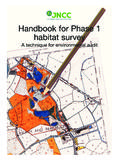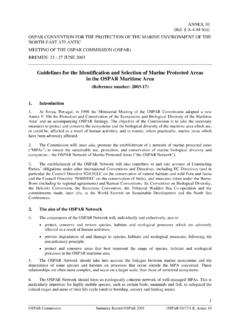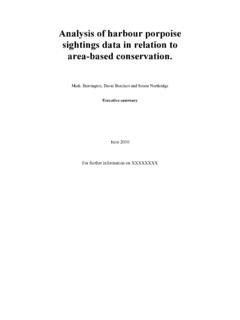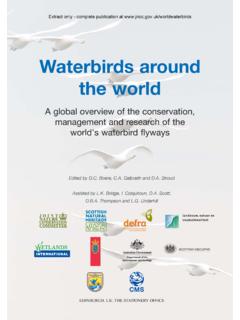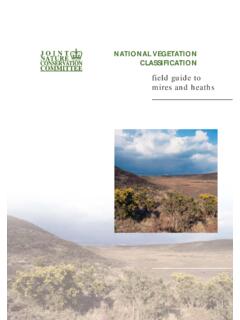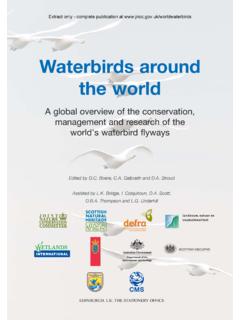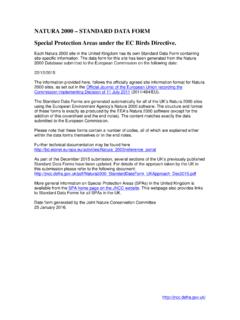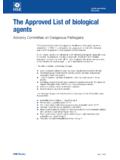Transcription of Health and safety in bat work - JNCC
1 Bat work may involve visits to sites that are potentially dangerous, particularly for those whohave received inadequate or insufficient trainingand are unaware of the correct safety measures. Itcannot be emphasised too strongly that safety is ofparamount importance in all situations. No site or colony is worth taking risks over, so if in doubtabort the visit. Always ask yourself whether youcould get the information you need without enteringa hazardous assessment plays an important part in ensuringthat bat group members operate in a safety -consciousway and bat groups can help by ensuring that safetyprocedures are discussed and reviewed 8 includes sample risk assessments forentry into buildings and disused should be aware that bat work is covered by Health and safety legislation. Asummary of the main requirements can be found in Appendix 8, including relevant Health and first aidIn Britain, bats rarely transmit diseases to man, butthe death of a batworker from the rabies-relatedEuropean Bat Lyssavirus (EBLV) in 2002 illustratesthe need to take steps to avoid being bitten, as itmust now be assumed that this virus is present inbats in the UK and this fatal disease can be contracted from a bat bite (see Box: Advice on batsand rabiesfor details).
2 In addition, it is always wiseto take simple hygiene precautions when visitingbat roosts. Always cover any open cuts beforeentering bat roosts and wash your hands after handling bats or their droppings and before eating,smoking or drinking. Anyone working with animalsor in dirty areas must ensure that their anti-tetanusimmunisation is kept up to to or, more especially, prolonged work in,some sorts of sites may carry a risk of Lyme disease is unlikely to be a hazardto bat workers, but work in sites contaminated bysewage or rats carries a risk of leptospirosis (Weil sdisease). A small number of cavers have contractedthis disease, indicating that there is a risk whereverthere is contact with water. If you work in suchsites, make sure you observe the hygiene precautions described above and report any influenza-like symptoms immediately to your doctor together with information about your Health AND FIRST AID 23 Health and safety in bat workA.
3 J. Mitchell-JonesA quick reference guide may be available fromyour SNCO a simple first-aid kit, and knowing how touse it, would be a sensible precaution for all sitevisits including those underground. Standard kitsare widely available and could be kept as a permanent part of your site visit Travel and night or lone workingTravelling to and from bat work and working atdusk or at night carries an element of personal riskwhich can be minimised by taking a few simpleprecautions. Avoid working alone wherever possible. Never go underground alone. Avoid sites with a reputation for incidents. This might apply particularly to night-time fieldwork at urban sites. Be aware of what is going on around you and the location of the nearest house or phone box. Remember that when wearing headphones withbat detectors you may be unaware of what is going on around you. Consider carrying a personal attack alarm.
4 Always tell someone reliable where you are going, what time you expect to return and whatto do if you don t turn up. Always keep to thesearrangements and phone if you are going to be late. Some SNCO offices have well-developed buddy systems or recording systems. These should be used where available. Don t rely on a mobile phone as you may be in an area with poor horseshoe bat colony. Frank GreenawayCHAPTER 2 Health AND safety IN BAT WORK 24(tel: 0141 300 1100) can provide advice to doctors or the public about the assessment of BCT office holds a list of all Animal Health DivisionalOffices (AHDOs) and their equivalents elsewhere and hasdetails of appropriate Health offices. A list of AHDOs can befound at of fresh dead bats to the Veterinary LaboratoriesAgency (VLA)To encourage an increase in the rabies dead bats should be sent by first-class mail to VLA as soon as possible (but not on a Friday).
5 If there is to be delay in posting, keep in a refrigerator (4 6 C) until the bat can be collected or posted. Rabies-related virus can beisolated from frozen or decomposing material, but the chances are enhanced in fresh unfrozen euthanasia is agreed, this can be carried out by a vet using intraperitoneal injection of a small volume of barbiturate; alternatively, gaseous anaesthesia can be used if facilities exist. Other methods are available but should avoid breaking the skin or of date, source and circumstances of finding shouldaccompany samples. If there is reason to be suspicious of the animal call your local Animal Health Divisional Office before dispatching the must comply with the Post Office regulations for pathological material. Carcasses should be packed in a tightly sealed container and surrounded by absorbent should be securely fastened and placed in a stout envelope or padded package must be marked Pathological specimen: Fragile with Care and sentby first-class post to VLA.
6 Packages should be clearly marked with a large red R next to the address. Suitable pre-paid envelopes, forms and specimen tubes are availablefree of charge from the Bat Conservation package should be sent to Rabies Diagnostics,Veterinary Laboratories Agency, New Haw, Addlestone,Surrey KT15 3NB. Some bat groups have had an arrangement with the Veterinary Officers of their local Animal Health Divisional Office regarding collection of bats for delivery to in other countries, the identification of all bats submitted to VLA is confirmed by an appropriate bat specialist and the material is subsequently passed to one of our national museums (mostly to Liverpool or Edinburgh).Taking bats into captivityBats should be held in captivity in accordance with the BatConservation Trust has confirmed that any captive bat that is still alive afterany necessary treatment and care can be considered safe torelease as soon as it is in a fit stateAll bats that die in captivity should be submitted to the VLA assoon as the discovery of European Bat Lyssavirus type 2 intwo Daubenton s bats in England and the death of a batworkerin Scotland from the same virus, it must now be assumed thatthis virus is present in bats in the of dead bats byMAFF/Defra over the last decade indicates that the overall incidence of infection is likely to be very low, although limitedtesting of live Daubenton s bats for antibodies suggests thatexposure to EBL2 may be more widespread.
7 Nevertheless,infected bat bites have caused human deaths so appropriateprecautions against infection must be Department of Health s recommendation is that peopleregularly handling bats should be vaccinated against in this category are all active bat workers and wardens, and those regularly taking in sick and injured SNCOs and the Bat Conservation Trust urge all thoseinvolved in bat work to ensure that they are fully vaccinatedand that they receive regular boosters. Bats should not be handled by anyone who has not received these when fully vaccinated, people should avoid being bitten bywearing appropriate bite-proof gloves when handling bats. Anybat bite should be thoroughly cleansed with soap and waterand advice should be sought from your doctor about the needfor post-exposure treatment. Further information is availablefrom the SNCOs, the Bat Conservation Trust or the HealthProtection Agency (HPA) /Scottish Centre for Infection andEnvironmental Health (SCIEH).
8 The BCT provides up to to the public who find grounded batsMembers of the public should be advised not to handle grounded advice from the Department of Health isthat there is no risk to the public provided they do not touchor pick up bats. It may be possible for a bat worker to visit toexamine the bat and retrieve it if local AnimalHealth Divisional Office (or its equivalent in Northern Ireland,Republic of Ireland, Isle of Man and Channel Islands) should becontacted if the bat is behaving abnormally or aggressively andfor which no explanation of its behaviour is readily should be remembered that there are hazards to both wild animal and human in inexperienced people handling any bat worker should establish whether the bat hasbitten anybody. If so, then the bat worker should considerencouraging the finder to collect the bat (using a box and cardboard slide, bite-proof gloves or a heavy cloth) into a boxwhere it can be examined a bat has bitten, or may have bitten, a member of the public,they should be advised to seek immediate medical advice.
9 Ifavailable, the bat should be retained in captivity for assessmentby an experienced person, or euthanasia applied, depending onthe assessed risk. Post-exposure treatment, which appears tobe highly effective, should be considered after discussions witha doctor or GP. The HPA (tel: 020 8200 4400) or SCIEH Advice on bats and rabiesSee also Transmission of safety in and around buildingsVisits to locate or inspect bat roosts in buildingsmay involve access to parts of the building that present particular safety hazards. It is important thatyou are properly equipped for such visits and areaware of the hazards that may exist. Refer to thesample risk assessment in Appendix 8. When youvisit a building, the occupier of those premisesshares a legal responsibility for your Health and Personal protective equipment (PPE)If it is necessary to enter a bat roost, proper equipment is essential and appropriate clothingshould be worn.
10 Overalls are recommended because they protect clothes from dirt and the body from splinters or irritation caused by fibreglass insulation. Shoes or boots with a thicksole should be worn to give protection against projecting nails; industrial safety boots or safetytrainers with nail-resistant soles are ideal. Toughgloves, such as gardening gloves, can give protection against splinters, nails and sharp use is a matter of individual preference,although gloves must always be worn for handlingbats. Dust masks should be worn if you have anyform of respiratory sensitivity and eye protectionmay be advisable when opening a loft hatch from hats can provide considerable protectionagainst falling objects or projecting nails, but theyneed a certain amount of care if they are to functionproperly. The hat must be a good fit, with the innerharness and strap adjusted properly. The gapbetween the harness and the plastic shell is essential for the proper functioning of the hat, so donot store anything there.

